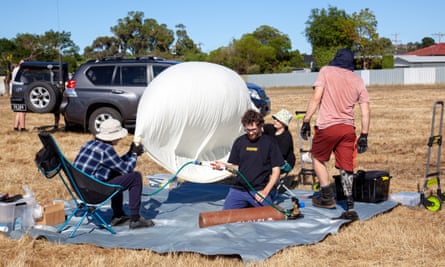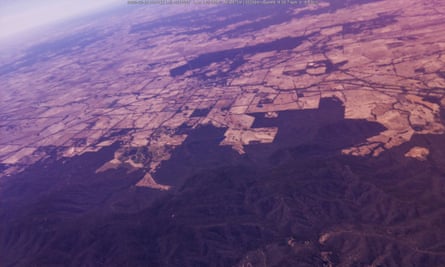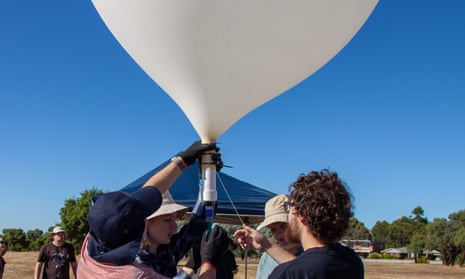Last Sunday, on a bright and cloudless morning, about 20 people gathered in a park in Ararat, in south-west Victoria, to release a balloon.
The hobbyists, members of the Eastern & Mountain District Radio Club’s high-altitude balloon group, loaded their aircraft with 400 grams of equipment: a GPS; sensors measuring temperature, pressure and humidity; and a camera that relayed pictures from the air every 30 seconds.
“It’s a fun opportunity for families, kids, adults of all ages to engage with Stem,” says Trevor Warren, who runs the group.
Filled with helium and made of latex, the balloon travelled 50km north-east and to an altitude of 30km before bursting. Some club members stationed themselves along its flight path.
The group’s high-altitude balloon is similar to the airborne objects that have recently come under scrutiny in North America. In the US, on 11 February a hobby group’s pico balloon went missing – the same day an unidentified object was shot down by a US F-22 jet over Canada.
The recent downing has some high-altitude balloonists worried. “The concern amongst hobbyists [in the US] is that they’re going to change the regulations and … make it impossible, or at the very least very difficult, to be able to do this hobby,” says Mark Jessop, a member of the Amateur Radio Experimenters Group.
As its name suggests, the Australian group, which has launched 60 balloons since 2010, is interested in using the objects to test out different radio communication techniques.
“Many other groups launch [balloons] for getting video, for sending up sensor payloads, scientific experiments, testing out hardware, space launches, all sorts of things,” Jessop says.
Jessop, who also runs a site that tracks amateur balloons globally, says the US hobby group’s missing object was a pico balloon, an ultra-lightweight flight. “These fly with … a polyethylene balloon which is designed to float. These expand but they don’t burst – they float at somewhere between 10 and 15 kilometres [altitude] and they can keep on travelling around the world.”
The balloons launched by amateurs in Australia are usually made from latex, and only fly for 100km or less.

Regulations enforced by Australia’s Civil Aviation Safety Authority (Casa) now make it effectively impossible for amateur Australian groups to launch balloons that travel internationally, Jessop says. Amateurs have, in the past, sent balloons internationally – in 2015, one Melbourne balloonist achieved nearly three global circumnavigations in a single flight.
“For us to be able to launch one of these tiny pico balloons, we are required to get approval from all of the countries that it might fly over, which, as you can imagine, might be somewhat challenging given we don’t necessarily know where it’s going to go.”
Comparatively, balloons used by researchers have greater directional control, says Dr Brad Tucker, an astrophysicist at the Australian National University. “For a lot of the astronomy ones … you are steerable, either using winds or devices on board. You can lower or raise your balloon a little bit to catch [wind] currents.”
after newsletter promotion
The distance a balloon will cover depends on the altitude it reaches and weight it is carrying. “Roughly, for every kilometre you go up, you lose a day in flight, and for every kilogram of weight you lose a day at that height,” Tucker says.
He points out that high-altitude balloons have been in use for many decades. In the early 1970s, Nasa established a balloon launch facility in Alice Springs, which is now operated by the University of New South Wales.
“When you get above the ozone layer, you can actually see ultraviolet colours. The ozone layer sits 20 to 35 kilometres [above Earth] – the higher you get, you can actually see ultraviolet colours into space or even monitor the Earth’s atmosphere.”
Such altitudes, Tucker says, enable scientists to measure the high-energy particles, known as cosmic rays, that “come through the Earth’s atmosphere before they get scattered on the way to the ground”.

Research balloons range from “anything from a few metres to a few storeys tall”, Tucker says. “As you go up, the balloon expands because of [lower] pressure, so they become quite large at altitude.”
The latex balloons that hobbyists use are typically less than 2m in diameter on the ground, Jessop says. The AREG uses parachutes with their flight, because they want what they’re flying to land gently and also be recoverable.
“This hobby has great Stem applications – getting people involved in science and radio communications. When the payloads that we’re flying are light, the risk is incredibly low.”
Casa requires a notice to air missions for every launch. “In Australia, we have a fairly lengthy approvals process,” Jessop says. “We’re not worried about getting our flights shot by an aircraft. We’re not worried at all.”

Comments (…)
Sign in or create your Guardian account to join the discussion